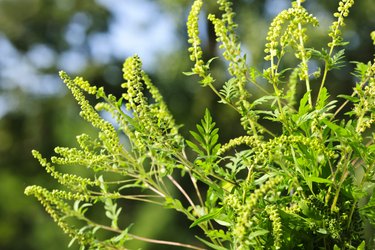
Goldenrod (Solidago L.) and ragweed (Ambrosia L.) are familiar plants to allergy sufferers. Both plants are members of the Asteraceae family and are distributed throughout the United States and Canada in U.S. Department of Agriculture hardiness zones 1 through 11. Blooming in the late summer and early fall, both plants have a reputation for causing hay fever. Luckily for allergy sufferers, the differences between goldenrod and ragweed are easy to identify.
Flower Differences
Video of the Day
Goldenrod flowers are bright yellow and grow in large masses resting on single stems. The flowers of ragweed are green to yellow and appear in smaller formations on branched stems. Often found growing side by side, goldenrod's showy flowers stand out against ragweed's pale blooms, causing it to be unfairly blamed for most pollen allergens. Goldenrod flowers contain nectar to attract pollinators, while ragweed flowers don't contain nectar, depending primarily on the wind for pollination.
Video of the Day
Pollen Dispersal
Both goldenrod and ragweed can be found blooming during the late summer, when hay fever allergies are common. Goldenrod pollen is large in size and is meant to be carried by pollinators, whereas ragweed produces a greater amount of small-grained pollen meant to be carried by the wind. The wind carries ragweed pollen so well that it has been found 400 miles out to sea and 2 miles up in the atmosphere. Seventy-five percent of Americans who are allergic to plant pollens are allergic to ragweed pollen.
Leaves & Stems
Goldenrod features smooth, unlobed leaves, while ragweed leaves are smooth with deep lobes. Both plants have alternately positioned leaves. Ragweed stems are purple and green in color and are hairy and branched, while goldenrod has a single green stem with no branching. Ragweed grows 1 to 5 feet tall, and goldenrod grows 1 to 4 feet tall.
Distribution
According to the United States Department of Agriculture, there are 75 species of goldenrod and 20 species of ragweed distributed throughout the United States and Canada. Each species differs greatly in distribution, with some species appearing in only a single state or territory. For example, whitehair goldenrod (Solidago albopilosa) occurs only in Kentucky. Both goldenrod and ragweed favor habitats in woodlands, roadside ditches and fallow fields.
Cultivated Weeds
Several cultivars of goldenrod are available from nurseries or seed companies for gardens and wildflower plantings. Selected because they exhibit sought-after characteristics such as seasonal color or prominent flowers, or because they fill a need in less than ideal growing situations, goldenrod cultivars can help round out a naturalized garden. Cultivated varieties don't necessarily enjoy the widespread hardiness of their wild counterparts. "Goldrush" (Solidago cutleri "Goldrush") and "Golden Fleece" (Solidago sphacelata "Golden Fleece") are suitable for USDA zones 4 through 9, and "Fireworks" (Solidago rugosa "Fireworks") is hardy in USDA zones 5 through 9.
- University of Florida IFAS Extension; Ragweed vs. Goldenrod; Alicia R. Lamborn; 2010
- Iowa State University Extension News; Goldenrod Falsely Accused; Linda Naee; 2007
- United States Department of Agriculture Plants Database: Solidago L.
- United States Department of Agriculture Plants Database: Ambrosia L.
- Asthma and Allergy Foundation of America: Ragweed Allergy
- University of Minnesota Extension; Goldenrod and Ragweed; Beth R. Jarvis; October 2008
- United States Department of Agriculture Plants Database: Solidago Albopilosa
- Fine Gardening: Genus Solidago